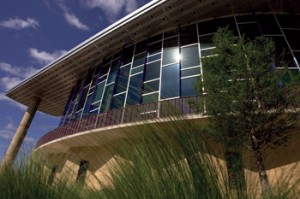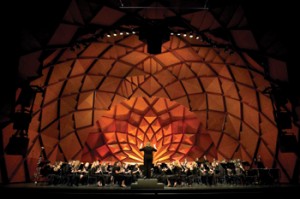Potter County
 Located in the High Plains of the Panhandle with a total land area of some 908 square miles, Potter County offers a niche for everyone, from the outdoor enthusiast to the arts connoisseur and the western history buff. For example, Wildcat Bluff Nature Center was named by early cowboys for a den of wildcats that lived under the cliff. The nature center is also the site of a branch of the historic Gregg-Marcy Wagon Trail from Santa Fe to Fort Smith where wagon ruts are still visible today. More than 600 acres of rolling grasslands are sectioned with nature trails offering beautiful wildflowers, huge cottonwoods, and a magnificent bluff.
Located in the High Plains of the Panhandle with a total land area of some 908 square miles, Potter County offers a niche for everyone, from the outdoor enthusiast to the arts connoisseur and the western history buff. For example, Wildcat Bluff Nature Center was named by early cowboys for a den of wildcats that lived under the cliff. The nature center is also the site of a branch of the historic Gregg-Marcy Wagon Trail from Santa Fe to Fort Smith where wagon ruts are still visible today. More than 600 acres of rolling grasslands are sectioned with nature trails offering beautiful wildflowers, huge cottonwoods, and a magnificent bluff.
Lake Meredith National Recreation Area sits some 30 miles north of the county seat of Amarillo and features the 10,000-acre Lake Meredith, an artificial reservoir created by Sanford Dam on the Canadian River
The Alibates Flint Quarries National Monument with more than a thousand acres was set aside in 1965 to preserve the flint quarries located above the Canadian River in Potter County. Guided tours are presented by park rangers during the summer months and at other times by reservation.
Visitors also frequent Cadillac Ranch, a public art installation created in 1974 by Chip Lord, Hudson Marquez and Doug Michels, who were a part of the art group Ant Farm. The collection consists of used or junk Cadillac automobiles representing a number of evolutions of the car line. These 10 Cadillacs are embedded hood-down in the windy, West Texas prairie, just waiting for someone to spray their initials on one of them.
Finally, the Globe-News Center is a world-class performing arts palace featuring a 1,300 seat auditorium and a soaring, multi-tiered lobby. The center serves as the performance home for The Amarillo Symphony, Amarillo Opera, and Lone Star Ballet.
Potter County Courthouse
The Potter County Courthouse located in downtown Amarillo was completed in 1931 and is one of the finest examples of high-rise Art Deco/Modern courthouses in the State of Texas. The courthouse was designed by the architecture firms of Townes, Lightfoot and Funk of Amarillo, and Page Brothers of Austin.
The building is a concrete structure with brick masonry exterior walls clad in cream colored terra cotta. The central block is eight stories tall with five story side wings. The exterior of the courthouse is adorned in decorative motifs depicting the region’s cultural and natural history.
In 2006, ARCHITEXAS was hired by Potter County to update the master plan and make recommendations for a full restoration to return the building to its 1931 completion date, a $17 million project with Journeyman Construction as construction manager.
 The interior and exterior of the courthouse were largely intact. However unsympathetic integration of MEP systems, installation of new partitions, removal of historic finishes and elements, and modifications to original built-in furnishings had compromised the historic appearance of much of the interior spaces. On the exterior of the building a full stone-by-stone survey was completed revealing failing and open mortar joints and select areas of deterioration to the terra cotta cladding.
The interior and exterior of the courthouse were largely intact. However unsympathetic integration of MEP systems, installation of new partitions, removal of historic finishes and elements, and modifications to original built-in furnishings had compromised the historic appearance of much of the interior spaces. On the exterior of the building a full stone-by-stone survey was completed revealing failing and open mortar joints and select areas of deterioration to the terra cotta cladding.
The goal of the project was to meet current building and accessibility codes, meet the operational and functional needs of the county’s administrative offices and courts, replace and upgrade MEP, building sprinkler, and A/V and IT systems, and reconstruct and/or restore missing or deteriorated historic elements and finishes throughout.
One of the more dramatic changes was the transition of the stark white and off-white color scheme to the restored MARB-L-COTE decorative finish in warm terra cotta hues, which was determined to be the original finish on walls in the public corridors and courtrooms. Potter County rededicated its county capitol in August 2012.
– Information provided by ARCHITEXAS
Potter county received funding for these restoration projects from the Texas Historical Commission Texas Courthouse Preservation Program.









